How to Get a Word Document Out of Review Mode
Lesson 26: Track Changes and Comments
/en/word2013/checking-spelling-and-grammer/content/
Introduction
Permit'south suppose someone asks you lot to proofread or interact on a document. If you had a printed copy, you might use a red pen to cross out sentences, marking misspellings, and add comments in the margins. Word allows you to do all of these things electronically using the Runway Changes and Comments features
Optional: Download our practice document.
Understanding Track Changes
When y'all turn on Track Changes, every change you make to the certificate volition appear equally a colored markup. If you delete text, it won't disappear—instead, the text will exist crossed out. If yous add text, it will exist underlined. This allows you to run into edits before making the changes permanent.
 Using Track Changes
Using Track Changes
If there are multiple reviewers, each person volition be assigned a different markup color.
To turn on Track Changes:
- From the Review tab, click the Rail Changes command.
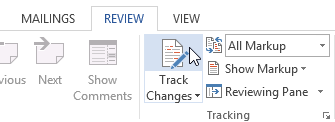 Turning on Rail Changes
Turning on Rail Changes - Track Changes will be turned on. From this point on, whatsoever changes you make to the document will appear as colored markups.
 Tracking changes
Tracking changes
Reviewing changes
Tracked changes are actually just suggested changes. To go permanent, they must exist accepted. On the other mitt, the original author may disagree with some of the tracked changes and choose to decline them.
To have or decline changes:
- Select the alter you want to have or pass up.
 Selecting a tracked change to accept or decline
Selecting a tracked change to accept or decline - From the Review tab, click the Accept or Refuse command.
 Accepting a change
Accepting a change - The markup will disappear, and Word will automatically jump to the next change. You tin continue accepting or rejecting each change until y'all have reviewed all of them.
 Subsequently accepting the modify
Subsequently accepting the modify - When you lot're finished, click the Rails Changes command to plow off Track Changes.
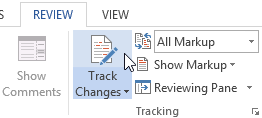 Turning off Track Changes
Turning off Track Changes
To have all changes at in one case, click the Accept drop-downwards arrow, and then select Accept All. If you no longer want to track your changes, you tin select Accept All and Stop Tracking.
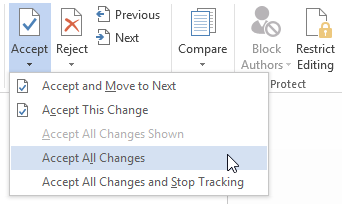 Accepting all changes
Accepting all changes
Rail Changes viewing options
If yous take a lot of tracked changes, they may become distracting if you're trying to read through the document. Fortunately, Word provides a few different means to customize how tracked changes appear, including the choice to hibernate tracked changes.
To hide tracked changes:
- From the Review tab, click the Brandish for Review command. The Display for Review control is located to the correct of the Track Changes command.
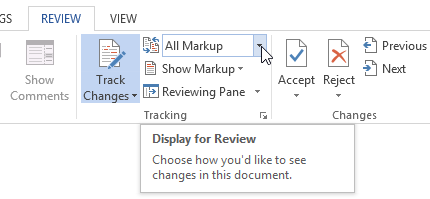 Clicking the Display for Review control
Clicking the Display for Review control - In the drop-downward menu, there are four options:
- Elementary Markup: This shows the final version without inline markups. Red markers will appear in the left margin to indicate where a change has been fabricated.
- All Markup: This shows the final version with inline markups.
- No Markup: This shows the terminal version and hides all markups.
- Original: This shows the original version and hides all markups.
- Select the desired option from the drop-down menu. In our example, we'll select No Markup to preview the terminal version of the document before accepting the changes.
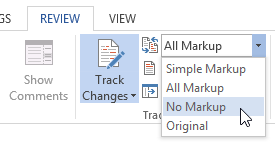 Selecting No Markup
Selecting No Markup
You can likewise click the marker in the left margin to switch between Uncomplicated Markup and All Markup.
 Clicking the marker to hibernate tracked changes
Clicking the marker to hibernate tracked changes
Hiding Track Changes is not the same as reviewing changes. Yous will still need to accept or refuse the changes before sending out the final version of your certificate.
To testify revisions in balloons:
Past default, most revisions appear inline, meaning the text itself is marked. You can too choose to show the revisions in balloons, which moves most revisions to the right margin. Removing inline markups can make the certificate easier to read, and balloons also give you more than detailed information nigh some markups.
- From the Review tab, click Bear witness Markup
 Balloons
Balloons  Show Revisions in Balloons.
Show Revisions in Balloons.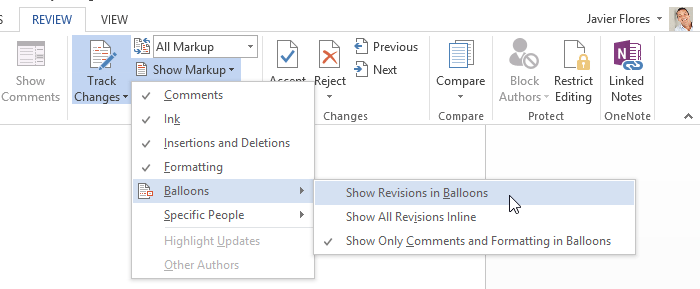 Clicking Show Revisions in Balloons
Clicking Show Revisions in Balloons - Most revisions volition appear in the right margin, although whatever added text volition withal announced inline.
 Runway changes in balloons
Runway changes in balloons
To go back to inline markups, yous can select either Show All Revisions Inline or Show Simply Comments and Formatting in Balloons.
Comments
Sometimes you may want to add a comment to provide feedback instead of editing a document. While information technology's frequently used in combination with Track Changes, you don't necessarily need to accept Track Changes turned on to utilise comments.
To add together comments:
- Highlight some text, or identify the insertion point where you want the annotate to appear.
 Selecting text
Selecting text - From the Review tab, click the New Comment command.
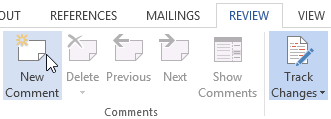 Clicking the New Comment command
Clicking the New Comment command - Type your comment. When you're done, you lot can close the comment box by pressing the Esc key or past clicking anywhere outside the comment box.
 Adding a annotate
Adding a annotate
You can too respond to an existing comment. Just click the Answer push and type your response.
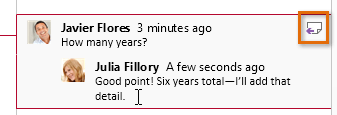 Replying to a comment
Replying to a comment
To delete comments:
- Select the comment you want to delete.
 Selecting a comment to delete
Selecting a comment to delete - From the Review tab, click the Delete command.
 Clicking the Delete command
Clicking the Delete command - The comment will be deleted.
 After deleting the annotate
After deleting the annotate
To delete all comments, click the Delete drop-down arrow and select Delete All Comments in Document.
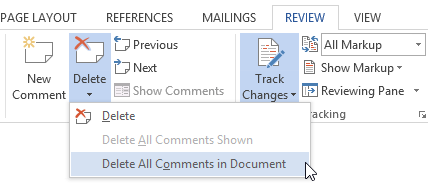 Deleting all comments
Deleting all comments
Comparing documents
If you edit a document without tracking changes, it's still possible to use reviewing features such as Accept and Reject. You tin can do this by comparing 2 versions of the document. All you need is the original document and the revised document (the documents must also have dissimilar file names).
To compare two documents:
- From the Review tab, click the Compare command, then select Compare... from the drib-down menu.
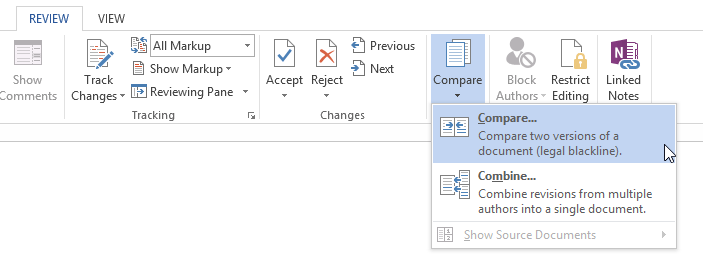 Clicking the Compare... command
Clicking the Compare... command - A dialog box will appear. Choose your Original document by clicking the drop-downwardly arrow and selecting the document from the list. If the file is not in the list, click the Browse push button to locate it.
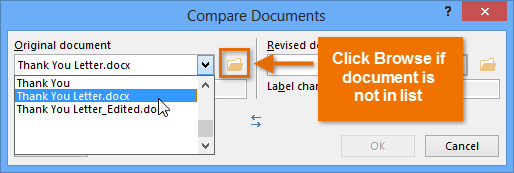 Selecting the original document
Selecting the original document - Choose the Revised document, then click OK.
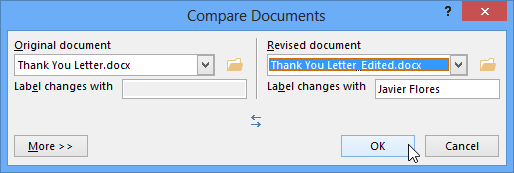 Choosing the revised document and clicking OK
Choosing the revised document and clicking OK - Word will compare the ii files to make up one's mind what was changed and and so create a new document. The changes will announced equally colored markups, merely like Rail Changes. Y'all can then use the Take and Decline commands to finalize the document.
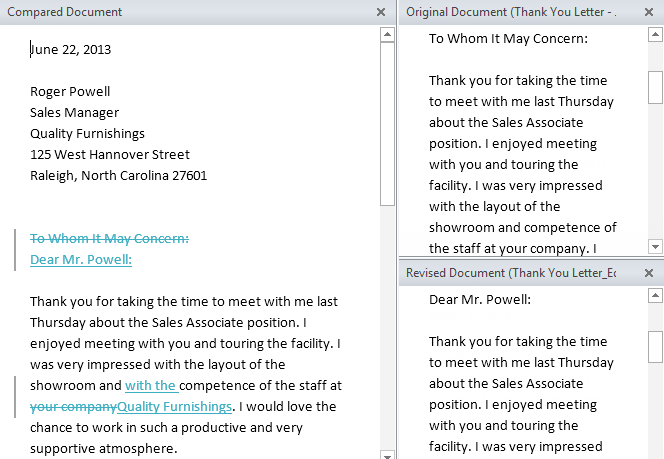 Comparing two documents
Comparing two documents
The original and revised documents will appear in a pane to the right that you can use for reference (although yous can't edit them). If y'all don't see the pane, click Compare ![]() Show Source Documents
Show Source Documents ![]() Show Both.
Show Both.
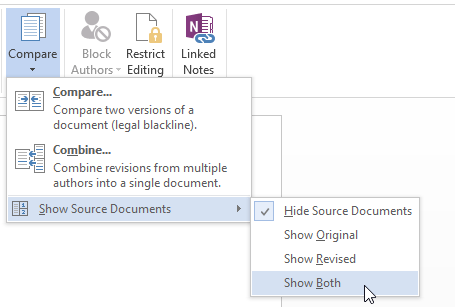 Showing both source documents
Showing both source documents
Challenge!
- Open an existing Word document. If you want, yous tin utilize the do document.
- Plough on Track Changes.
- Delete some text.
- Add some text.
- Change some of the text formatting.
- Experiment with the Display for Review command.
- Accept all of the changes, then turn off Track Changes.
/en/word2013/finalizing-and-protecting-documents/content/
Source: https://edu.gcfglobal.org/en/word2013/track-changes-and-comments/1/
0 Response to "How to Get a Word Document Out of Review Mode"
Post a Comment